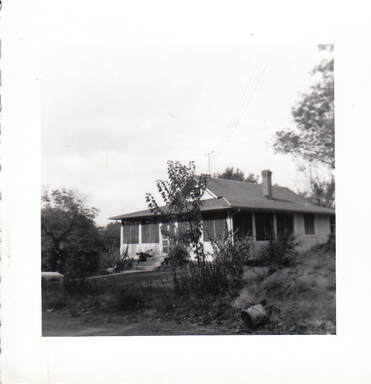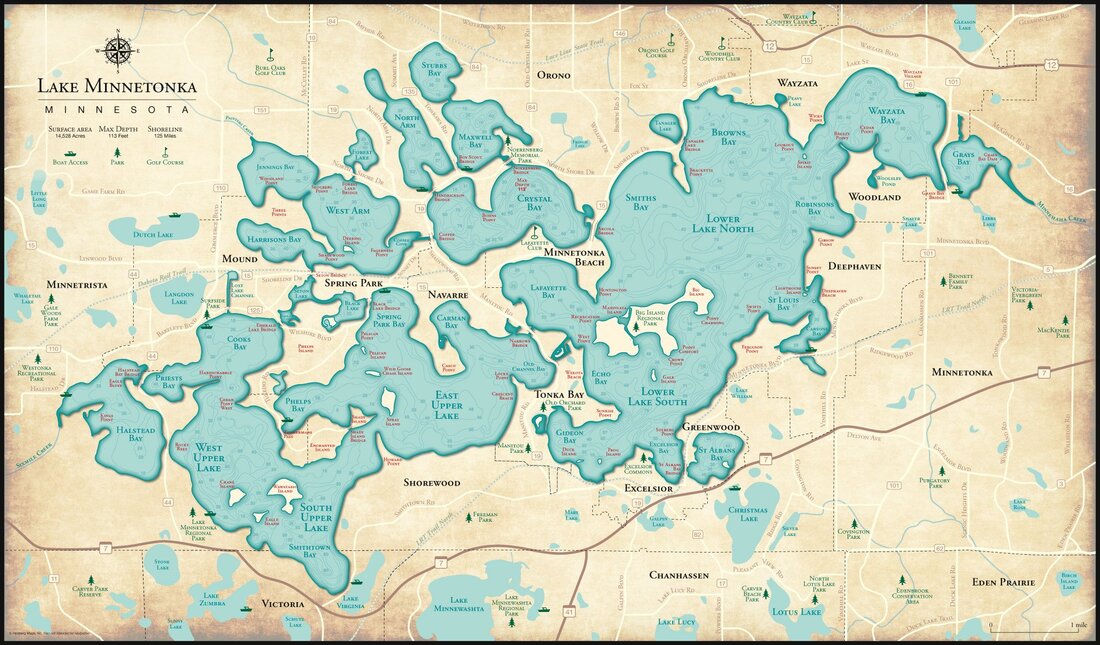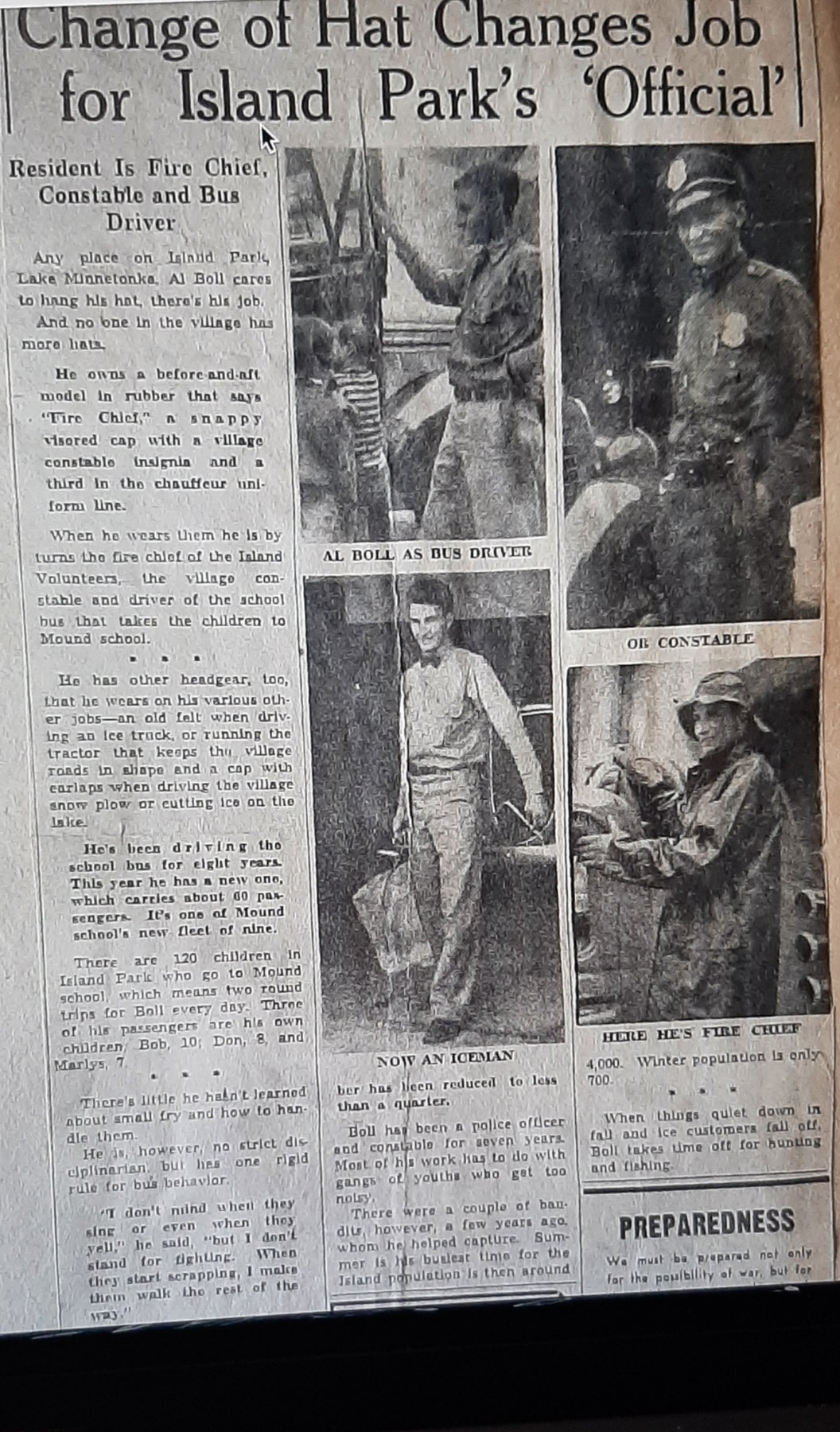THE LAKE -- THE MAN
The lake was a hallowed and mystic place to the Dacotah, and the Chippewa/Ojibway Indians that visited her banks. They hunted and fished from her shores. They worshiped her waters and believed that it was a holy place inhabited by the four winds. The lake surface could be flat and still as glass, a deep blue reflection of the cloudless midsummer sky, or dappled with ripples when touched by Shawondasee, the South Wind. They feared her wrath when the North Wind, Kabibonokka1, would whip her surface into foam curled waves of water as black as the night. And they loved her beauty.
| With over one hundred miles of shoreline, Minnetonka consists of myriad bays and channels, islands and bogs, with hardwood forest touching waters edge. The lake, known to the Dacotah as Minnetonka (Big Water), is the source of a small creek that winds its way through the hardwood forest, gaining volume from natural springs and surface runoff. Flowing easterly, the creek feeds a falls near historic Fort Snelling on the Mississippi River. Longfellow immortalized the falls in his poem “The Song of Hiawatha”. | It was here that the arrow-makers daughter, Minnehaha captured the heart of the powerful Hiawatha. Early explorers followed the creek above Minnehaha Falls to its source, and the lake held sacred by the red man, was no longer able to hide its beauty from the white man. With the influx of white settlers and “discovery” of the lake by Eastern visitors, the original inhabitants were forced to relinquish their claim to the lake they held sacred. |
Travel around the lake was possible only by boat or canoe and there was a serenity and peaceful quality that overcame her visitors. Through word of mouth and journalistic articles in Eastern newspapers, the Lake and surrounding land became a favorite resort area during the late 1800’s and early 1900’s, and served as a playground for the rich and famous during that period. Summer homes for the rich eventually gave way to year around dwellings that were inhabited by working class residents, most of them with an itch that could only be scratched by living a remote existence, far from the lights of any city.
 then RR3 Box 148 — now 4650 Manchester Rd.
then RR3 Box 148 — now 4650 Manchester Rd. Our house was built in the early 1900’s and was on a cleared piece of property near the crest of a hill. It was designed as a summer home and as such, hosted a huge screen porch that ran across the front and curved to the rear around both sides of the interior room. Our front yard terminated at a dirt road, which ran past the house, a low hedge forming the demarcation. The other side of the road yielded to heavily wooded topography that was prevalent on the island.
The screen door, in the middle of the front porch, faced directly south. The West wing of the porch became the summer dining room and was accessed by French doors leading to the inside dining room. My mother always moved the dining room table onto the screen porch during the summer months. It was strange, how the food seemed to taste better when warm wind breezed across our faces! Or when we could smell the aroma that accompanied the summer rains.
| The East wing became my bedroom during the summer months. My feet were towards the rising sun, and the head of the bed was against the inside wall of the porch. The porch was the magnificent summer bedroom of my youth. It’s still there, a little smaller than it was when I was young, the East end having been sacrificed for a larger living room by my parents after I enlisted in the Navy. Nonetheless, it looks the same from the front and every time I drive by the place, I am | transported to an earlier time. The area behind the house remained relatively flat for about 30 feet before falling sharply on a steep incline for another 30 feet or so, where it met the edge of the swamp. The original residents of the house built a horse shed at the edge of the hill. Designed to overhang the slope, they dug huge timbers into the hillside to act as braces for the rear of the structure. The floor planking was two inch thick oak, with some planks of 24 inch widths. |
Double doors, that opened toward the house, led to the stable area, and there was a small room that served for tack storage on one side. My older sister, Jill, would later paint the words, “Saturday Playhouse” on the doors, and together with Joyce, the neighbor, present stage productions for the families.
THE MAN
The late forties and early fifties were a time of tremendous change on the island. I remember the ice truck delivering block ice to many of the residents. As original summer homes, they relied on the “ice box” to refrigerate perishables, and many people relied on the deliveries. Al Boll-The Iceman, in retrospect, was the first entrepreneur that I ever knew. He controlled the ice business, cutting the blocks of ice from the frozen lake during the winter and storing them in the icehouse under heaps of coarse wood shavings. He placed the blocks in rows, layer upon layer, each covered with an ample thickness of wood shavings, which acted as insulation against the inevitable heat that came with the summer season.
In addition to controlling the ice business, our resident entrepreneur was the Fire Chief, local constable, and he ran the snow plowing and road sanding operation for the island. With a position of high influence, it was natural for all the implements required in the pursuit of his interests, to be close at hand. It was no coincidence that the icehouse, the fire station attached to the Village Hall, and the garage for the dump truck/snow plow combination were clustered adjacent to his house. This concentration of buildings and equipment was located at the end of the straight stretch of road that ran in front of our house and was the center of the island’s activity during the early years. In 1940, the Island Park Village Hall was on her way to building a tight community that would last into the 60s.


 RSS Feed
RSS Feed
